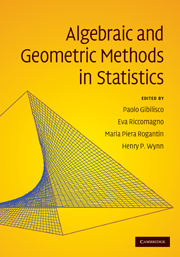Book contents
- Frontmatter
- Contents
- List of contributors
- Preface
- Frequently used notations and symbols
- 1 Algebraic and geometric methods in statistics
- Part I Contingency tables
- Part II Designed experiments
- Part III Information geometry
- 14 Introduction to non-parametric estimation
- 15 The Banach manifold of quantum states
- 16 On quantum information manifolds
- 17 Axiomatic geometries for text documents
- 18 Exponential manifold by reproducing kernel Hilbert spaces
- 19 Geometry of extended exponential models
- 20 Quantum statistics and measures of quantum information
- Part IV Information geometry and algebraic statistics
- Part V On-line supplements
15 - The Banach manifold of quantum states
from Part III - Information geometry
Published online by Cambridge University Press: 27 May 2010
- Frontmatter
- Contents
- List of contributors
- Preface
- Frequently used notations and symbols
- 1 Algebraic and geometric methods in statistics
- Part I Contingency tables
- Part II Designed experiments
- Part III Information geometry
- 14 Introduction to non-parametric estimation
- 15 The Banach manifold of quantum states
- 16 On quantum information manifolds
- 17 Axiomatic geometries for text documents
- 18 Exponential manifold by reproducing kernel Hilbert spaces
- 19 Geometry of extended exponential models
- 20 Quantum statistics and measures of quantum information
- Part IV Information geometry and algebraic statistics
- Part V On-line supplements
Summary
Abstract
We show that a choice of Young function, for quantum states given by density operators, leads to an Orlicz norm such that the set of states of Cramér class becomes a Banach manifold. A comparison is made with the case studied by Pistone and Sempi, which arises in the theory of non-parametric estimation in classical statistics.
The work of Pistone and Sempi
The work of (Pistone and Sempi 1995) arises as a generalisation to infinitely many parameters of the theory of the best estimation of parameters of a probability distribution, using the data obtained by sampling. It is also sometimes called ‘nonparametric estimation’. In 1995, Pistone and Sempi obtained a notable formalism, making use of an Orlicz space. From the point of view of quantum mechanics, the classical case corresponds to the special case where all observables generate an abelian algebra. The quantum case of a finite-dimensional Hilbert space leads to the theory of quantum information, but does not involve delicate questions of topology; this is because all norms on a space of finite dimension are equivalent. The question arises, whether we can imitate the use of an Orlicz norm in the infinite-dimensional case. We here show that this is possible, by completing the outline made earlier (Streater 2004a). We must start with a brief review of the classical case. We follow (Streater 2004a), with minor corrections.
(Pistone and Sempi 1995) develop a theory of best estimators (of minimum variance) among all locally unbiased estimators, in classical statistical theory.
- Type
- Chapter
- Information
- Algebraic and Geometric Methods in Statistics , pp. 257 - 264Publisher: Cambridge University PressPrint publication year: 2009



